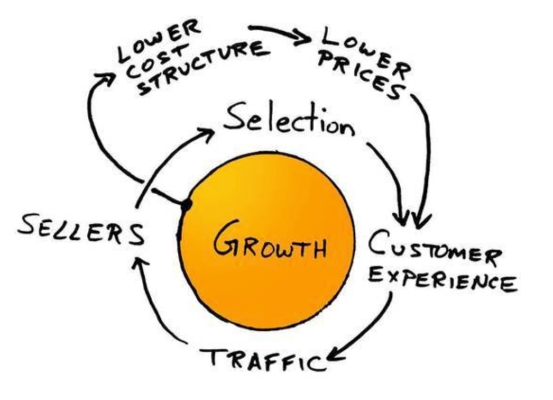When products think: AI product flywheel
#235 - Apr.2025
In my previous article, I shared how AI is transforming product management. We're moving from command-based to intent-based interactions with software, which changes the foundations of how we design, build, and run products.
So how do we build great products in this new paradigm?
AI Product Flywheel
I like the concept of flywheels.
I learned this idea at Amazon, where the flywheel represents the elements that reinforce their strategy.
In any strategy, rather than a single component, many pieces need to work together. If they reinforce each other, the momentum creates a virtuous cycle that delivers exponential value.

In Amazon's case, growth is driven by offering a great customer experience. If customers like it, they'll visit the website (Traffic). This traffic helps gain and retain Sellers, as they have a bigger market for their products. This win-win situation allows Amazon to offer a wide selection of products which, ultimately, attracts more customers.
Similarly, growth enables reducing costs through economies of scale, which allows offering even lower prices to customers.
It's a self-reinforcing loop.
Thinking about this new reality of product management, I tried to identify which components, when working together within a strategy, could become a self-reinforcing loop for AI products.
I'm calling it the AI Product Flywheel.

You'll notice something distinct about this flywheel. It exists within a larger environment of context awareness.
AI-powered products will be different from what we know today. They'll be able to make decisions and predict outcomes better than humans in certain areas.
AI provides a new level of context awareness. For businesses, this means understanding internal processes, competitors, economic trends, and more. Products can now spot patterns in this data and adapt in real-time as things change.
This continuous evolution is a new variable we need to consider when designing solutions.
At the center of this flywheel is Customer + Business Outcomes - the measurable results a product delivers for both your customers and your business.
Customer Trust
We begin with Customer Trust.
In the digital economy, trust is the foundation of any product or service.
Trust is created at every interaction, through consistency and transparency. This becomes even more important for solutions using AI. We need guardrails to handle unexpected responses and provide options to customers when products fail to deliver on their requests.
We continue designing for people with expectations and emotions. How we handle these expectations will make a huge difference.
Greater Adoption
If we create strong trust bonds with customers, they'll come back for more. Adoption in a digital economy is very dynamic. Customers can easily look for alternatives in a market where new solutions emerge daily.
The network effect of happy customers is powerful.
More customers also creates the opportunity to refine AI-based systems through more contextual data and feedback, understanding different environments and use cases.
Iterative Value Delivery
Serving a larger customer base creates the leverage to iterate and deliver value consistently. With more users engaging with the product, you gain valuable insights that inform your development priorities.
Success in AI product development comes not from building entire platforms upfront, but from identifying, building, and refining features that demonstrate clear value.
It's about embracing experimentation, creating MVPs in days, not weeks.
Delivering on your promise (value proposition) with each iteration demonstrates that you care about the problem you're solving - and customers will notice this, reinforcing trust.
Ethical Learning & Feedback
As you grow and serve more customers, you gain opportunities to learn how they use your product. AI products mature through use. They require continuous evaluation against real-world scenarios, not just test data.
We must collect user feedback and data in an ethical way. Putting ethics and privacy first is a major shift that product leaders need to embrace.
When we commit to ethical design, we build customer trust. We also help create a society where privacy matters.
Customers should understand how their feedback translates into meaningful improvements while respecting their privacy.
Enhanced AI Capabilities
Enhanced AI capabilities are how we turn customer feedback into technical features. These might be better recommendations, improved language understanding, or automation that predicts what users need.
This connects directly back to customer trust. When customers see their feedback turned into real improvement they feel the product is made for them.
The most successful AI products create a loop where capabilities evolve based on actual usage patterns, not just engineering assumptions.
Discover actionable insights and expert tips to transform how you approach innovation, technology, and creativity. Practical tools you can apply immediately. Yes, they are free!
How the flywheel builds momentum
Each of these elements reinforces the next in a continuous cycle:
- Customer + Business outcomes as the end-goal
- Customer trust as the starting point of the flywheel
- Customer trust enables greater adoption
- Greater adoption powers iterative value delivery, which reinforces customer trust
- As we generate customer + business outcomes, we start serving a larger customer base, leading to more feedback
- This feedback is then applied to create enhanced AI capabilities which, ultimately, brings more customers who trust the product
All of this happens in an environment where the system constantly monitors, understands, and adapts to changes.
To know if your flywheel is gaining momentum, establish metrics for each component. Metrics such as:
- Trust: Customer satisfaction scores and retention rates
- Adoption: Active users and feature usage
- Value delivery: Feature delivery times and customer outcome improvements
- Ethical learning: Privacy satisfaction and quality of feedback
- Enhanced capabilities: Accuracy improvements and personalization effectiveness
Customer Trust must be the foundation of all AI product design decisions.
The technology may change over time, but our focus must remain on delivering measurable value for both customers and the business.
I encourage you to test this flywheel with your own AI solutions.
Mastering this flywheel—that builds trust, drives adoption, delivers value iteratively, learns ethically, and enhances AI capabilities—will define the next generation of digital products.
¡Saludos!


